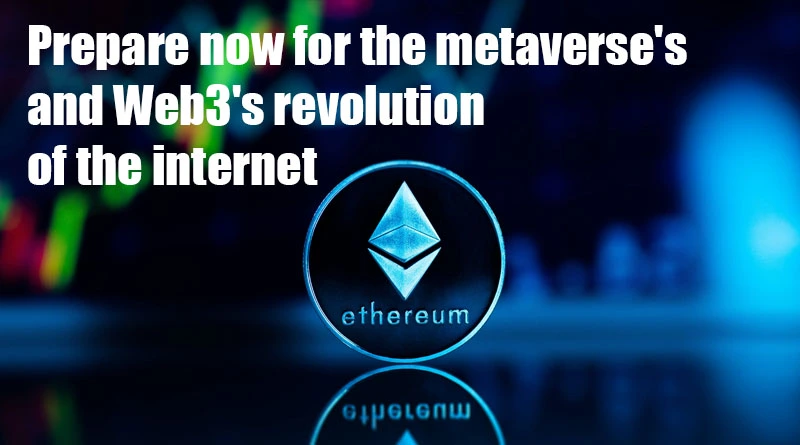The internet of today is a fragmented network of websites, applications, and platforms. They are not interoperable or data portable because they are independent of one another.
Therefore, despite the enormous advancements brought about by digital transformation, the current model will eventually stifle business growth. In actuality, 95% of CEOs polled for 2022
According to the Accenture Technology Vision research, in order to facilitate the interoperability of consumer data across platforms and places, future digital platforms will need to offer unified experiences.
Two novel concepts that will help the internet get around these restrictions are the metaverse continuum, an advancement of the internet that enables users to participate in a persistent shared experience across the real world and the virtual world, and Web3, which refers to developing efforts to build a “distributed” layer to the internet using technologies like blockchain and tokenization.
Together, these are demonstrating the next iteration of the internet, one that transcends the fragmented interaction of the present and ushers in a new realm of continuous immersive encounters.
1-The internet reimagined with Web3 and the metaverse:
Simply put, the digital world is evolving, and eventually the metaverse and Web3 will play a significant role in how businesses coordinate their digital strategy.
The online footprints that businesses have created over the last ten years will be redesigned, from the services sold and the data that can be accessed to the advertising strategies and content creation processes.
The metaverse will change the internet into a persistent, place-based 3D environment where moving from one social network to another merely needs crossing a street.
Web3 technologies will simultaneously develop a data layer that supports authenticity, trust, and even scarcity. The value of this new internet will increase tremendously while becoming more human-centric.
The time has come for businesses to decide what part they will play in the development of the internet. Will they be willing to passively observe how this future develops, or do they want to be a part of the wave that makes it?
2-Change indicator:
In the past 18 months, changes in the digital world have made it evident that a “wait and see” strategy will soon give way to “look — it already happened.” In fact, businesses are already adopting new perspectives on the digital sphere and gaining new benefits.
BMW, for instance, recently created digital twins of 31 various factories. The models recreate everything from the machinery on the floor to the people filling stations and their unique work-order instructions in a photo-realistic 3D environment using real-time data.
The application of the digital twins includes simulating individual task training, bringing together designers from around the world for research, and teaching robots how to navigate factories.
Employees can make use of the environment to push software updates, monitor individual cells for interruptions, assign new “missions” to the floor’s robots, and teleoperate machines for certain tasks.
Solid, which was developed by Inrupt and helps users manage their data and save it in personal online data stores, is a notable example of Web3 innovation (Pods).
Now, big businesses and governments can create websites or apps that communicate with pods and, with users’ permission, access the data they require for certain activities. Similar to other Web3 technologies, Solid makes diverse parties the decision-makers for their own data, establishing a transaction and trust layer across the web.
Adoption of technology and associated services commonly snowball in the online environment. After all, only 15 years have passed since the first iPhone was released and there are 6.6 billion telephones in use worldwide. The internet of the future will quickly resemble the one we have today.
3-Things to do right away:
The potential of new goods and services should be investigated by business leaders immediately, and their executives should be trained in the technologies that will soon become the backbone of their industry.
The businesses ready and eager to experiment with new platforms and data structures will be the ones that define the future generation of digital business as metaverse and Web3 technologies continue to develop. There are numerous things to think about:
1-Put money into the cloud:
The platforms and services that make up the emerging metaverse will define it. Enterprises need the technology to share apps broadly and securely in order to even exist.
This entails rewriting cloud-based apps using microservice architectures and APIs to make them simple for others to use and share. Even though it’s unclear what the metaverse will look like in the end, these actions need to be made right away.
2-Emphasis on skills:
Businesses will need 3D artists, game designers, and specialists in the platforms created for the metaverse.
Businesses pursuing Web3 potential will need knowledge of several blockchains. They will need to establish connections with various consortiums, look for partners to enter the market with, and create new operating and commercial models. Fortunately, it is now simpler than ever to begin experimenting with these technologies because to the growing sophistication and democratisation of immersive design tools.
3-Locate partners:
It’s also crucial to establish new alliances and make sure your company can take part in future partnerships. The role of industry standards groups and consortiums in fostering more corporate interoperability and simplifying the delivery of cross-platform experiences will be crucial.
Businesses can position themselves to offer more compatible services to future shared consumers by agreeing on a common framework when a technology is still in its infancy.
Significant technological advancements like the metaverse and Web3 are redefining how data is used throughout digital experiences while also removing friction between the many digital platforms of today.
New business ventures, new methods of operation, and new ways for people and businesses to engage will all be fueled by the development of a new internet. For many businesses, this is their first and best chance to design a brand-new form of digital environment.

